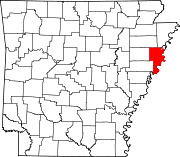Anthonyville, Arkansas
Anthonyville, Arkansas | |
|---|---|
 Community building and fire station | |
 Location of Anthonyville in Crittenden County, Arkansas. | |
| Coordinates: 35°02′23″N 90°20′25″W / 35.03972°N 90.34028°W | |
| Country | United States |
| State | Arkansas |
| County | Crittenden |
| Area | |
• Total | 0.08 sq mi (0.20 km2) |
| • Land | 0.08 sq mi (0.20 km2) |
| • Water | 0.00 sq mi (0.00 km2) |
| Elevation | 207 ft (63 m) |
| Population (2020) | |
• Total | 135 |
| • Density | 1,753.25/sq mi (679.95/km2) |
| Time zone | UTC-6 (Central (CST)) |
| • Summer (DST) | UTC-5 (CDT) |
| FIPS code | 05-01457 |
| GNIS feature ID | 2405155[2] |
Anthonyville is a town in Crittenden County, Arkansas, United States. The population was 161 at the 2010 census,[3] down from 250 in 2000.
Geography
[edit]Anthonyville is located in southern Crittenden County. Arkansas Highway 147 forms the eastern boundary of the town and leads north 9 miles (14 km) to Interstate 40, 15 miles (24 km) west of Memphis, Tennessee. Highway 147 continues south 7 miles (11 km) to the Horseshoe Lake area.
According to the United States Census Bureau, Anthonyville has a total area of 0.12 square miles (0.3 km2), all land.[3]
Demographics
[edit]| Census | Pop. | Note | %± |
|---|---|---|---|
| 2000 | 250 | — | |
| 2010 | 161 | −35.6% | |
| 2020 | 135 | −16.1% | |
| U.S. Decennial Census[4] | |||
2020 Census
[edit]| Race / Ethnicity (NH = Non-Hispanic) | Pop 2000[5] | Pop 2010[6] | Pop 2020[7] | % 2000 | % 2010 | % 2020 |
|---|---|---|---|---|---|---|
| White alone (NH) | 7 | 14 | 4 | 2.80% | 8.70% | 2.96% |
| Black or African American alone (NH) | 241 | 144 | 127 | 96.40% | 89.44% | 94.07% |
| Native American or Alaska Native alone (NH) | 0 | 0 | 0 | 0.00% | 0.00% | 0.00% |
| Asian alone (NH) | 0 | 0 | 0 | 0.00% | 0.00% | 0.00% |
| Pacific Islander alone (NH) | 0 | 0 | 0 | 0.00% | 0.00% | 0.00% |
| Other race alone (NH) | 0 | 0 | 0 | 0.00% | 0.00% | 0.00% |
| Mixed race or Multiracial (NH) | 0 | 3 | 4 | 0.00% | 1.86% | 2.96% |
| Hispanic or Latino (any race) | 2 | 0 | 0 | 0.80% | 0.00% | 0.00% |
| Total | 250 | 161 | 135 | 100.00% | 100.00% | 100.00% |
As of the census[8] of 2000, there were 250 people, 82 households, and 52 families residing in the town. The population density was 877.5 people/km2 (2,273 people/sq mi). There were 87 housing units at an average density of 305.4 units/km2 (791 units/sq mi). The racial makeup of the town was 2.80% White, 96.40% Black or African American, 0.80% from other races. 0.80% of the population were Hispanic or Latino of any race.
There were 82 households, out of which 34.1% had children under the age of 18 living with them, 34.1% were married couples living together, 23.2% had a female householder with no husband present, and 35.4% were non-families. 32.9% of all households were made up of individuals, and 14.6% had someone living alone who was 65 years of age or older. The average household size was 3.05 and the average family size was 4.02.
In the town, the population was spread out, with 38.4% under the age of 18, 6.4% from 18 to 24, 24.4% from 25 to 44, 15.6% from 45 to 64, and 15.2% who were 65 years of age or older. The median age was 31 years. For every 100 females, there were 115.5 males. For every 100 females age 18 and over, there were 108.1 males.
The median income for a household in the town was $23,750, and the median income for a family was $32,344. Males had a median income of $25,357 versus $18,636 for females. The per capita income for the town was $8,825. About 28.4% of families and 32.2% of the population were below the poverty line, including 36.2% of those under the age of eighteen and 48.7% of those 65 or over.
Education
[edit]Residents are zoned to schools in the West Memphis School District,[9] which operates Academies of West Memphis (formerly West Memphis High School).
References
[edit]- ^ "2020 U.S. Gazetteer Files". United States Census Bureau. Retrieved October 29, 2021.
- ^ a b U.S. Geological Survey Geographic Names Information System: Anthonyville, Arkansas
- ^ a b "Geographic Identifiers: 2010 Demographic Profile Data (G001): Anthonyville town, Arkansas". U.S. Census Bureau, American Factfinder. Archived from the original on February 12, 2020. Retrieved June 19, 2014.
- ^ "Census of Population and Housing". Census.gov. Retrieved June 4, 2015.
- ^ "P004 Hispanic or Latino, and Not Hispanic or Latino by Race – 2000: DEC Summary File 1 – Anthonyville town, Arkansas". United States Census Bureau.
- ^ "P2 Hispanic or Latino, and Not Hispanic or Latino by Race – 2010: DEC Redistricting Data (PL 94-171) – Anthonyville town, Arkansas". United States Census Bureau.
- ^ "P2 Hispanic or Latino, and Not Hispanic or Latino by Race – 2020: DEC Redistricting Data (PL 94-171) – Anthonyville town, Arkansas". United States Census Bureau.
- ^ "U.S. Census website". United States Census Bureau. Retrieved January 31, 2008.
- ^ "SCHOOL DISTRICT REFERENCE MAP (2010 CENSUS): Crittenden County, AR" (PDF). U.S. Census Bureau. Retrieved May 14, 2018. Note: Since the production of the map, the Hughes School District merged into the West Memphis school district in 2015

